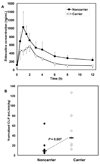Interindividual variability in pharmacokinetics of generic nucleoside reverse transcriptase inhibitors in TB/HIV-coinfected Ghanaian patients: UGT2B7*1c is associated with faster zidovudine clearance and glucuronidation
- PMID: 19628728
- PMCID: PMC2749505
- DOI: 10.1177/0091270009338482
Interindividual variability in pharmacokinetics of generic nucleoside reverse transcriptase inhibitors in TB/HIV-coinfected Ghanaian patients: UGT2B7*1c is associated with faster zidovudine clearance and glucuronidation
Abstract
There are limited data on the pharmacokinetics of generic nucleoside reverse transcriptase inhibitors (NRTIs) in native African populations, in whom they are commonly used. The authors characterized the pharmacokinetics of lamivudine (n = 27), zidovudine (n = 16), and stavudine (n = 11) in human immunodeficiency virus (HIV)/tuberculosis (TB)-coinfected Ghanaians and evaluated associations between zidovudine metabolism and UDP-glucuronosyltransferase (UGT) 2B7 polymorphisms. Lamivudine, zidovudine, and stavudine apparent oral clearance (CL/F) values (mean +/- SD [% coefficient of variation [CV]) were 7.3 +/- 2.8 (39%), 31.9 +/- 33.6 (106%), and 16.4 +/- 5.8 (35%) mL/min/kg, respectively, whereas half-life values were 4.2 +/- 1.9 (46%), 8.1 +/- 7.9 (98%), and 1.5 +/- 1.0 (65%) hours, respectively. Zidovudine CL/F was 196% higher (P = .004) in UGT2B7*1c (c.735A>G) carriers versus noncarriers. This was confirmed using human liver bank samples (n = 52), which showed 48% higher (P = .020) zidovudine glucuronidation and 33% higher (P = .015) UGT2B7 protein in UGT2B7*1c carriers versus noncarriers. In conclusion, generic NRTI pharmacokinetics in HIV/TB-coinfected Ghanaians are similar to other populations, whereas the UGT2B7*1c polymorphism may explain in part relatively high interindividual variability in zidovudine clearance.
Conflict of interest statement
All authors report no conflict of interest.
Figures





Similar articles
-
Pharmacokinetics of zidovudine and lamivudine in neonates following coadministration of oral doses every 12 hours.J Clin Pharmacol. 2001 Jul;41(7):732-41. doi: 10.1177/00912700122010636. J Clin Pharmacol. 2001. PMID: 11452705 Clinical Trial.
-
Pharmacokinetic characteristics of ritonavir, zidovudine, lamivudine, and stavudine in children with human immunodeficiency virus infection.Pharmacotherapy. 2004 Apr;24(4):453-9. doi: 10.1592/phco.24.5.453.33343. Pharmacotherapy. 2004. PMID: 15098798 Clinical Trial.
-
Effect of ribavirin on intracellular and plasma pharmacokinetics of nucleoside reverse transcriptase inhibitors in patients with human immunodeficiency virus-hepatitis C virus coinfection: results of a randomized clinical study.Antimicrob Agents Chemother. 2005 Oct;49(10):3997-4008. doi: 10.1128/AAC.49.10.3997-4008.2005. Antimicrob Agents Chemother. 2005. PMID: 16189072 Free PMC article. Clinical Trial.
-
Stavudine plus a non-thymidine nucleoside reverse transcriptase inhibitor as a backbone for highly active antiretroviral therapy.Antivir Ther. 1998;3 Suppl 4:39-43. Antivir Ther. 1998. PMID: 10723508 Review.
-
Guide to major clinical trials of antiretroviral therapy administered to patients infected with human immunodeficiency virus.Clin Infect Dis. 1996 Jul;23(1):15-27. doi: 10.1093/clinids/23.1.15. Clin Infect Dis. 1996. PMID: 8816123 Review. No abstract available.
Cited by
-
Evidence for regulation of UDP-glucuronosyltransferase (UGT) 1A1 protein expression and activity via DNA methylation in healthy human livers.J Pharm Pharmacol. 2013 Jun;65(6):874-83. doi: 10.1111/jphp.12053. Epub 2013 Mar 21. J Pharm Pharmacol. 2013. PMID: 23647681 Free PMC article.
-
Variability in Human In Vitro Enzyme Kinetics.Methods Mol Biol. 2021;2342:443-479. doi: 10.1007/978-1-0716-1554-6_16. Methods Mol Biol. 2021. PMID: 34272704
-
Evaluation of clinical and genetic factors in the population pharmacokinetics of carbamazepine.Br J Clin Pharmacol. 2021 Jun;87(6):2572-2588. doi: 10.1111/bcp.14667. Epub 2020 Dec 14. Br J Clin Pharmacol. 2021. PMID: 33217013 Free PMC article.
-
Secondary metabolism pathway polymorphisms and plasma efavirenz concentrations in HIV-infected adults with CYP2B6 slow metabolizer genotypes.J Antimicrob Chemother. 2014 Aug;69(8):2175-82. doi: 10.1093/jac/dku110. Epub 2014 Apr 11. J Antimicrob Chemother. 2014. PMID: 24729586 Free PMC article. Clinical Trial.
-
Identification and validation of the microRNA response elements in the 3'-untranslated region of the UDP glucuronosyltransferase (UGT) 2B7 and 2B15 genes by a functional genomics approach.Biochem Pharmacol. 2017 Dec 15;146:199-213. doi: 10.1016/j.bcp.2017.09.013. Epub 2017 Sep 28. Biochem Pharmacol. 2017. PMID: 28962835 Free PMC article.
References
-
- DHHS. US Department of Health and Human Services (DHHS) Panel on Antiretroviral Guideline for Adults and Adolescents. Guidelines for the use of antiretroviral agents in HIV-1-infected adults and adolescents. 2008. Nov [Accessed on January 10, 2009]. Available at http://www.aidsinfo.nih.gov/ContentFiles/AdultandAdolescentGL.pdf.
-
- Hammer SM, Eron JJ, Jr, Reiss P, et al. Antiretroviral treatment of adult HIV infection: 2008 recommendations of the International AIDS Society-USA panel. JAMA. 2008;300:555–570. - PubMed
-
- WHO. World Health Organization: Geneva, Switzerland; 2006. [Accessed on January 10, 2009]. Antiretroviral therapy for HIV infection in adults and adolescents in resource-limited settings: towards universal access. Available at http://www.who.int/hiv/pub/guidelines/artadultguidelines.pdf.
-
- Anderson PL, Lamba J, Aquilante CL, Schuetz E, Fletcher CV. Pharmacogenetic characteristics of indinavir, zidovudine, and lamivudine therapy in HIV-infected adults: a pilot study. J Acquir Immune Defic Syndr. 2006;42:441–449. - PubMed
Publication types
MeSH terms
Substances
Grants and funding
LinkOut - more resources
Full Text Sources
Molecular Biology Databases

